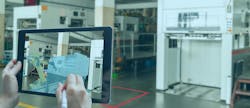Immersive AR/VR Technologies in Manufacturing: Case Studies, Benefits
We're in the midst of an evolution with immersive technology. Marketing efforts Meta's Oculus and Apple's Vision Pro emphasize consumer-centric applications such as gaming, but this consumer-centric focus belies the fact that serious developers are laying the groundwork for immersive technology to transcend entertainment.
Case Study: DHL
Logistics giant DHL implemented AR in its "vision picking" initiative, outfitting warehouse personnel with smart glasses to streamline the picking process. These developments represent merely the tip of the iceberg for an industry that boasted an approximate value of $8 billion in 2022 and is projected to witness nearly 30% growth over the next seven years.
The applications of immersive technology span diverse fields, with manufacturing emerging as one of the most promising arenas for its integration.
Understanding Immersive Technology: Key Definitions
Immersive technology serves as an umbrella term encompassing experiences that meld the real world with digital and/or simulated elements. This broad category can be subdivided into three types of immersive experiences:
- Augmented Reality (AR): AR overlays digital imagery onto the physical environment, often in real-time, frequently leveraging smartphones for interaction.
- Virtual Reality (VR): VR immerses users in entirely digital environments and requires a headset.
- Mixed Reality: An emergent combination of VR and AR facilitated by advancements in headset technology, seamlessly integrating digital objects into physical surroundings.
Each of these immersive modalities boasts distinct use cases, all of which carry significant implications for the realm of manufacturing.
Case Study: Hyundai
Hyundai embraced VR in its design processes to streamline vehicle development. Hyundai can create virtual prototypes of vehicles, allowing designers to interact with digital models of their cars in a virtual environment before any physical prototypes are made. This not only speeds up the design process but also reduces the costs and complexities associated with traditional prototyping. According to Hyundai, their VR-based design tools enable real-time feedback and adjustments to vehicle models, improving both quality and efficiency in the design stage. The company has also used VR to test the ergonomics and safety features of vehicles, ensuring that they meet stringent standards before physical testing begins.
Manufacturing Processes Benefits
- Simplified Prototyping, Enhanced Design: Immersive technologies offer a solution to historically cumbersome aspects of product iteration, such as physical prototyping. For instance, Ford's FIVE (Ford Immersive Vehicle Environment) VR technology empowers engineers to generate virtual prototypes of prospective vehicles without the logistical challenges of physical manufacturing.
- Enhanced Training and Skill Development: Immersive technologies hold promise in augmenting training programs within manufacturing, mitigating risks associated with on-the-job learning. Workers can engage in virtual environments to familiarize themselves with machinery and processes, thereby reducing injury risks, expediting training and minimizing overhead costs.
- Improved Planning and Collaboration: Immersive technologies streamline tasks like factory floor planning, enabling manufacturers to assess and optimize operational setups without the time-intensive and resource-heavy requirements of physical testing. Moreover, these technologies facilitate seamless international collaboration among engineering teams, accelerating prototyping and iteration cycles.
Manufacturing operations are inherently delicate endeavors; a single disruption can have cascading effects, impeding, or halting production altogether. In fact, recent studies have shown that unscheduled downtime can incur costs exceeding $125,000 per hour. Immersive technologies hold the potential to mitigate or eradicate such impediments, ensuring uninterrupted workflow within manufacturing processes.
Case Study: Boeing
Boeing uses VR for product design and employee training. VR technology simulates the assembly process, enabling engineers to test designs and workflows without physical prototypes, allowing rapid iteration and problem-solving. Boeing has also employed VR for astronaut training, conducting simulations to prepare astronauts for space missions. Training includes practical and emergency scenarios, familiarizing crew members with spacecraft systems and processes. By creating immersive training environments, Boeing aims to reduce risks and minimize errors.
Integrating AR, VR into Manufacturing
Integration of VR and AR need not be an overwhelming endeavor. Even modest implementations of immersive technology can yield substantial dividends. The most effective approach involves identifying strategic use cases and target areas for integration, whether it be streamlining training modules or experimenting with AR initiatives during assembly processes.
Incremental adoption of immersive technology ensures a smoother and more efficient integration process, with each step building upon the last.
Immersive technology developers play a pivotal role in this integration journey, guiding manufacturers through the adoption process and identifying optimal utilization within specific business contexts. By embracing immersive technology, today's manufacturers stand to realize immediate and profound benefits across various facets of their operations, from prototyping and training to production and safety.
Embracing innovation demands patience, foresight, and a willingness to experiment—qualities already ingrained within the manufacturing ethos.
Case Study: ASCO Power Technologies
In addition to design and training, immersive technologies are making significant strides in marketing and promotion. For instance, ASCO Power Technologies, a leader in power solutions, has implemented a VR experience to engage potential customers and partners in their products. ASCO uses VR to create an interactive, virtual environment where users can explore their complex power systems in a highly visual and accessible manner. This technology allows users to experience the intricacies of ASCO's solutions in a way that traditional presentations or brochures cannot match, enhancing customer understanding and driving sales.
About the Author
Nik Froehlich
Nik Froehlich is CEO of Saritasa, a custom technology solutions company developing complex software systems for automotive and other manufacturing companies in addition to logistics providers.
